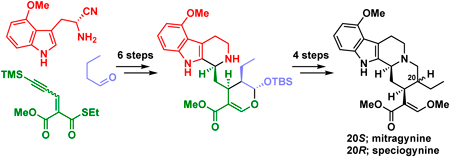- 著者
- Nanako Nakashima Jukiya Sakamoto Kenta Rakumitsu Mariko Kitajima Lia Dewi Juliawaty Hayato Ishikawa
- 出版者
- The Pharmaceutical Society of Japan
- 雑誌
- Chemical and Pharmaceutical Bulletin (ISSN:00092363)
- 巻号頁・発行日
- vol.70, no.2, pp.187-191, 2022-02-01 (Released:2022-02-01)
- 参考文献数
- 23
- 被引用文献数
- 5
A new pentacyclic monoterpenoid indole alkaloid glycoside named secorubenine (1) was isolated from the heartwood of Adina rubescens, collected in Indonesia. The structure was elucidated by spectroscopic analysis and chemical modification of isolated secorubenine (1). The bioinspired enantioselective total synthesis of 1 was accomplished in 12 steps, whereafter its structure was determined and the absolute stereochemistry was confirmed.
- 著者
- 鈴木 富之 岩崎 颯太 石川 隼人 石渡 大夢 鈴木 萌 中山 歩美 前野 有咲 松井 日菜 横山 朋花 Tomiyuki SUZUKI Sota IWASAKI Hayato ISHIKAWA Hiromu ISHIWATA Moe SUZUKI Ayumi NAKAYAMA Arisa MAENO Hina MATSUI Tomoka YOKOYAMA
- 出版者
- 宇都宮大学地域デザイン科学部
- 雑誌
- 地域デザイン科学 : 宇都宮大学地域デザイン科学部研究紀要 = Journal of the School of Regional Design Utsunomiya University (ISSN:24326704)
- 巻号頁・発行日
- no.10, pp.333-348, 2021-09-01
- 著者
- Jukiya Sakamoto Mariko Kitajima Hayato Ishikawa
- 出版者
- The Pharmaceutical Society of Japan
- 雑誌
- Chemical and Pharmaceutical Bulletin (ISSN:00092363)
- 巻号頁・発行日
- vol.70, no.9, pp.662-668, 2022-09-01 (Released:2022-09-01)
- 参考文献数
- 34
- 被引用文献数
- 8
A number of alkaloids found in Mitragyna species belonging to the Rubiaceae family have been shown to have potent biological activity such as analgesic properties. Here, we report the asymmetric total syntheses of mitragynine, speciogynine, and 7-hydroxymitragynine, which are classified as corynantheine-type monoterpenoid indole alkaloids, isolated from Mitragyna speciosa. These syntheses were accomplished within 12 steps and in >11% total yield from commercial 3-(trimethylsilyl)propanal using an organocatalytic anti-selective Michael reaction and bioinspired transformations.
- 著者
- Syuuto Toyoda Morihiro Oota Hayato Ishikawa Shinichiro Sawa
- 出版者
- Japanese Society for Plant Biotechnology
- 雑誌
- Plant Biotechnology (ISSN:13424580)
- 巻号頁・発行日
- vol.38, no.1, pp.157-159, 2021-03-25 (Released:2021-03-25)
- 参考文献数
- 18
Root-knot nematodes (RKNs, genus Meloidogyne) are a class of plant parasites that seek out and infect the roots of many plant species. The identification of RKN attractants can be used in agriculture in conjunction with nematode-trapping technology to redirect RKN movements and eventually reduce their prevalence in the field. Here, we discovered that some commercial silica gels can attract nematodes. Silica gels that attract nematodes contain calcium sulfate. Calcium sulfate and calcium carbonate showed strong nematode attraction properties. When plant seeds were surrounded by calcium sulfate or calcium carbonate, nematodes were not attracted to the plant seeds. We propose that calcium sulfate and calcium carbonate can be used in agriculture as a novel material to trap RKN.

